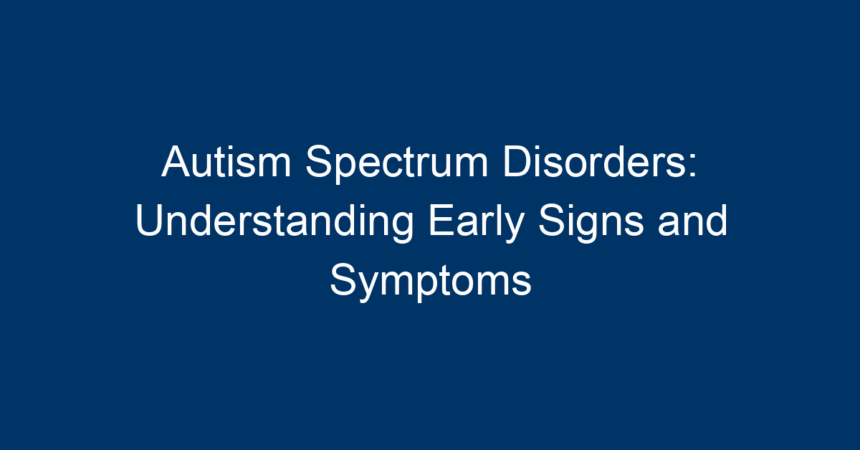Autism Spectrum Disorders (ASD) encompass a range of neurodevelopmental conditions that affect communication, behavior, and social interaction. As awareness of autism grows, understanding its early signs and symptoms becomes crucial for parents, caregivers, and educators. Early detection can significantly influence outcomes, allowing for timely intervention and support. This article will delve into the nuances of autism spectrum disorders, highlighting essential early signs and symptoms, and providing actionable insights.
What Are Autism Spectrum Disorders?
Autism Spectrum Disorders refer to a group of complex neurodevelopmental conditions characterized by challenges in social skills, repetitive behaviors, speech, and communication. The term “spectrum” indicates the wide variability in strengths and challenges among individuals with the disorder. The Centers for Disease Control and Prevention (CDC) estimates that 1 in 44 children is diagnosed with ASD in the United States.
Types of Autism Spectrum Disorders
There are several recognized types of autism spectrum disorders, including:
- Autistic Disorder (Classic Autism): Characterized by significant language delays, social challenges, and unusual behaviors.
- Asperger’s Syndrome: Involves milder symptoms, particularly around social interaction, but with no significant delays in language.
- Pervasive Developmental Disorder – Not Otherwise Specified (PDD-NOS): A diagnosis for individuals with some features of autism who do not meet the criteria for any specific type.
Understanding these distinctions helps in recognizing the diverse manifestations of autism spectrum disorders and the importance of tailored interventions.
Early Signs of Autism Spectrum Disorders
Recognizing the early signs of autism can lead to earlier intervention, which is key to helping children develop essential skills. Below, we break down some of the most common early signs and symptoms of autism spectrum disorders.
Social Interaction Challenges
Children with autism spectrum disorders often exhibit unique social behaviors. Key signs include:
- Limited Eye Contact: Infants may appear less responsive to social cues, displaying little to no eye contact.
- Lack of Shared Interest: Children might not point at objects to share experiences with others or show interest in social games.
- Difficulty in Understanding Emotions: Struggles to read emotions or respond to social cues can become apparent.
Communication Difficulties
Communication is a core area affected by autism spectrum disorders. Pay attention to:
- Delayed Speech Development: Some children may not speak at all, while others might have a delayed onset of speech.
- Echolalia: Repeating words or phrases heard elsewhere—often without understanding their meaning—can be a significant indicator.
- Unusual Tone or Rhythm: Children may use abnormal pitch or rhythm of speech, which can suggest underlying difficulties.
Repetitive Behaviors and Routines
Repetitive behaviors often characterize autism spectrum disorders. Signs include:
- Stereotyped Movements: Hand-flapping, rocking back and forth, or spinning objects are common.
- Strong Attachment to Routines: A child may become extremely distressed if routines are changed.
- Fixation on Specific Interests: Intense focus on particular topics or objects can demonstrate an atypical way of processing information.
Sensory Processing Issues
Many children with autism spectrum disorders experience sensory sensitivities. Signs may include:
- Over- or Under-Sensitivity: Children may react strongly to loud sounds or become distressed with certain textures.
- Unusual Responses to Pain: Some may not appear to feel pain as expected, while others may have a heightened sensitivity.
The Importance of Early Diagnosis
Early diagnosis of autism spectrum disorders allows for timely interventions that can make a considerable difference in a child’s development. Early intervention strategies may include:
- Speech Therapy: Helping children develop better communication skills.
- Behavioral Therapy: Assisting in managing social skills and daily living activities.
- Occupational Therapy: Supporting sensory integration and skill acquisition.
Statistics and Research
Research indicates that early intervention can lead to improved outcomes in communication, social skills, and symptom reduction. According to the CDC, early access to intervention for children with autism spectrum disorders can improve their academic performance and support their social skills.
How to Support Children with Autism Spectrum Disorders
Supporting a child diagnosed with autism spectrum disorders requires understanding, patience, and informed approaches. Here are actionable strategies to consider:
Educate Yourself
Learning about autism spectrum disorders is paramount. Resources such as books, workshops, and online courses can broaden your understanding and ability to assist.
Foster an Inclusive Environment
Creating a supportive environment where the child feels valued is key. Encourage interactions with peers and provide structured playtime to develop social skills.
Encourage Communication
Utilize visual aids, sign language, or alternative communication systems like picture exchange communication systems (PECS) to support children facing communication challenges.
Focus on Strengths
Every child with autism spectrum disorders has unique strengths. Celebrate these strengths and tailor learning experiences to utilize them fully. For instance, if a child excels at math, use numbers to teach social concepts.
Seek Professional Help
Engaging with specialist services for assessments, therapies, and personalized strategies can greatly benefit the child and their family.
Conclusion
Understanding early signs and symptoms of autism spectrum disorders is vital for fostering awareness and promoting early intervention. Parents, educators, and caregivers can make a significant difference in the lives of children with ASD by recognizing these signs and taking proactive steps. By educating ourselves, creating supportive environments, and harnessing the strengths of these unique individuals, we can pave the way for their growth and development. Early intervention is key, so stay vigilant, informed, and engaged in the journey. Together, we can create inclusive communities that appreciate the diversity of every individual on the autism spectrum.
Embracing understanding and compassion can create a ripple effect, making a substantial positive impact on the lives of those affected by autism spectrum disorders.




